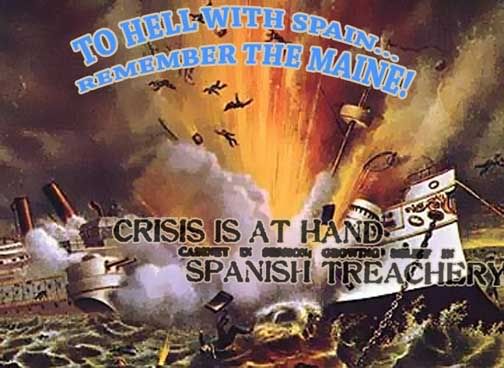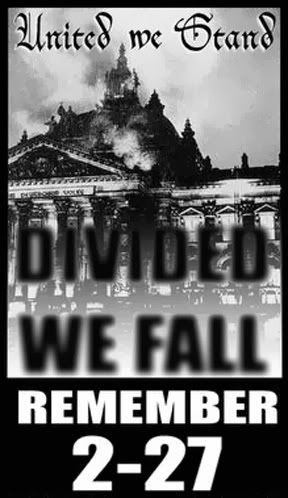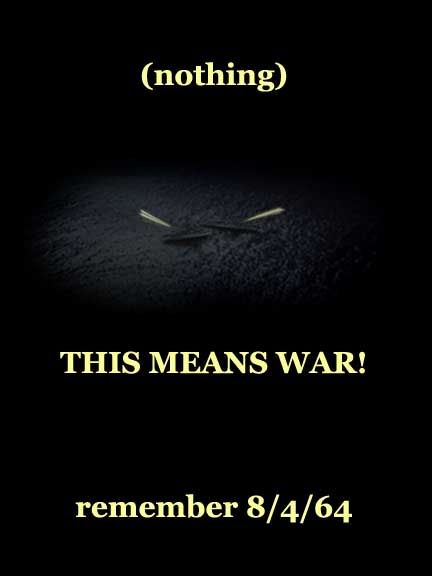[Tonkin Gulf Incident series
Adam Larson / Caustic Logic
June 5 2009
last update 6/5 3am
ORIGINS: CHINA SWALLOWS ITS PRIDE
It’s impossible to understand the Gulf of Tonkin Incident without first knowing the chain of decisions that brought two American ships into the place and the mindset necessary for the non-events that triggered a war. This mission was a “Desoto patrol,” a recent invention dating back to early 1962. As NSA historian Robert Hanyok later explained, these missions had twin objectives: “to collect intelligence in support of the embarked commander and higher level authorities and to assert freedom of navigation in international waters.” [1]
In a Desoto patrol, an unescorted destroyer, detached from the seventh fleet, sails as far as possible into enemy waters, flaunting their concept of territory while collecting intelligence for eventual hostile use. The first such mission was carried out by USS DeHaven, captained by RADM. James W. Montgomery, who later wrote of his experience penetrating the defenses of the People’s Republic of China. [2] Whether by direct order or prerogative allowed by the mission, they ignored all warnings, including the “serious” and “last” kind, each time answering with the ship’s name only. As the tense situation dragged on for days, it became essentially a high-stakes game of chicken with the risk of triggering a major war. There were psych-outs and elevated blood pressure on both sides of the coast line, but luckily (??) no shots were fired before the DeHaven finally left. Montgomery explained the importance of such a dangerous mission:
“The special operation was a then highly-classified intelligence gathering and probing excursion by USS DeHAVEN into waters that had not been visited by Pacific Fleet men-of-war since the late 1940s.” [3]
Desoto is of course the name of a famous Spanish explorer and Conquistador, which seems apt since these patrols were meant for re-exploring closed-off foreign territories, in support of Imperialist ambitions against Communist Asia. Montgomery however cites the name origin as an acronym for his own mission: “DEHAVEN Special Operations off TsingtaO” (DESOTO), which would better read DESOOT if that had the same resonance. [4] Whatever its name, the endeavor had the effect of forcing China to swallow its pride and keep swallowing ‘til it choked, as well as learning some nifty tidbits.
PATROLLING VIETNAM: JUST IN CASE
As Washington fretted over the devolving situation in Vietnam in 1964, direct military leverage against North Vietnam (DRV) was being considered. As William Rust explained for an excellent 1984 article in US News and World Report, the idea was to curb the North’s example to and support for the rebellious parts of the Capitalist-ruled, U.S.-supported South Vietnam. The principles for possible war were laid out by National Security Adviser McGeorge Bundy on May 25; an initial strategy of "selected and carefully graduated military force” if push were to come to shove. [5] This decision was passed from the White House to the Pentagon, who set to working out specific details.
Desoto patrols had been carried out regularly in the interim, including along the North Vietnamese coast, but at this time it was decided to expand them; on July 15, Rust reports, the commander of the Pacific Fleet proposed new missions to gauge DRV coastal defenses. [6] The article cites this as being Admiral Ulyses S. Grant Sharp, but according to some sources, he had been replaced with Adm. Thomas H. Moorer nearly a month prior. [7] So whichever Admiral or on whatever date, the ensuing activity was certainly overseen, and enthusiastically, by Adm. Moorer. Earlier, when he had commanded the Seventh Fleet, he issued a directive in early 1963 “broadening the conduct of the Desoto Patrols,” writes merchant marine researcher Steve Edwards. Moorer also “relaxed the restrictions on approach distances,” allowing ships as close as four nautical miles from enemy land, which is key to what happened the following August. [8]
Again, the objectives here were to “collect intelligence and to assert freedom of navigation in international waters.” [9] The first appears to have some possible merit in this case, which I’ll discuss below, but the second, asserting “rights” as with the first such mission is troubling. In fact they had no right, as Rust reported for US News:
“The instruction to approach no closer than 8 nautical miles to the coast, and 4 miles to the offshore islands, had a provocative edge: Although Hanoi had never publicly announced the width of its territorial waters, naval-intelligence officials suspected that Hanoi would claim the 12-mile limit observed by other Communist nations. In effect, the Maddox had the delicate task of stimulating coastal defenses without provoking an attack.” [10]
The danger in agitating defenses is clear; just recall that the best sort of defense is often though to be offense. NSA historian Robert J. Hanyok may have been saying the same thing (depending on what was redacted here), while tying it together with the Signals Intelligence (SIGINT) mission:
“U.S. intercept sites in the area were alerted to the real reason for the Desoto missions, which was to stimulate and record North Vietnamese [***** redacted text *****] reactions in support of the U.S. SIGINT effort.” [11 emph. in original, but italics]
Presenting the two aspects more separately, CINCPAC Sharp later explained the first objective "was to update our overall intelligence picture in case we had to operate against North Vietnam.” [12] The first strikes following the non-events of August 4 were by aerial bombardment, as they had likely decided from the start. This only seems natural and hardly worthy of mention, except that coastal defense information seems only slightly related to the planned operations.
Determining what kind of radar and anti-aircraft installations they have along the shore might prove useful, if they ever had the go-ahead to start bombing. In the meantime however, the gathering of peripheral information for potential air strikes risked a deadly incident that would necessitate… ahhh, well now it makes sense. Their dual mission could, if found intolerable enough, trigger a third and hidden aspect of the Desoto mission – to start a war. Only from this highly cynical point of view does a continued patrol regimen seem like an indisputably good idea. Rust explains how it was accepted:
“The Joint Chiefs and civilian authorities promptly approved Desoto; on July 17, the destroyer Maddox received orders to locate and identify radar transmitters, collect navigational information and conduct electronic surveillance along the North Vietnamese shoreline.” [13]The ship was equipped with special listening booths attached to the deck – small trailers filled with equipment and room for the Naval Security Group detachment “whose presence defined this cruise as a DeSoto Patrol,” writes National Security Archive-associated researcher John Prados. [14] She set off from Taiwan, the patrol course was set, and Maddox got to work in Tonkin Gulf on July 31.
OPLAN 34-A: DOUBLE-SHOT STIMULATION
Recalling the observations above about the delicate art of stimulating defenses without eliciting an attack, the Maddox’s passes of the gulf were always in the shadow of yet further provocations - confusing commando sneak attacks designed in part to stimulate communications to spy on. [15] If not by design, these ventures also wound up increasing the likelihood of a challenge to an American destroyer’s right to be there (up to and including attack with intent to sink).
The rubric for these extra missions was something usually called “OPLAN 34-A.” These were joint ventures with South Vietnamese and other forces to cause “pinprick” damages to the DRV. Activities ranged from espionage to covert land strikes and, relevant here, coastal attacks by swift patrol boat raids in the dead of night. The United States generally has denied any involvement in these "purely Vietnamese" operations, but of course it was the Pentagon that coined the 34-A name, and at the very least they favored and promoted the strikes, and kept close track of their effects.
Desoto patrols and 34-A actions were in fact seen as feeding each other in a cycle. NSA’s Hanyok describes one side: “in early July, General Westmoreland requested more intelligence on Hanoi's forces which were capable of defending against an expanded OPLAN-34A program. […in response…] Admiral Sharp, CINCPAC, issued a new directive for a Desoto patrol whose purpose was "determining DRV coastal patrol activity." [16] John Prados shows the other: “In fact the mission of the Maddox was specifically to record North Vietnamese radar and other electronic emissions which could be expected to spike after a 34-A raid.” [17] More raids = better intel = better raids = more intel = what???
The Maddox was ordered to stay close to the coast, and as close as four miles from any of the gulf islands. Including Hon Me, attacked by South Vietnamese commandos on July 30, followed by nearby strikes on August 1 and 2. Maddox captain John Herrick was at first not even informed how much more difficult his balancing act had been made, and was completely surprised in the afternoon of August 2 when three highly-stimulated DRV PT (patrol/torpedo) boats shot out from behind Hon Me and gave chase.
The boats were small with smaller guns of minimal range, but their torpedoes were potentially lethal even to a destroyer. In this case, the Americans flinched and ran, shooting back along the way. The PT boats were no match for the destroyer’s five-inch guns and the air cover swiftly arriving from the USS Ticonderoga. Between defensive actions and orders from on high to cancel the unapproved and stupid attack, it ended with no American deaths or injuries and no damage to the Maddox, compared to 2/3 of the attacking force being sent to the bottom. There was thus little actual danger of a follow-on attack, but that was probably not as clear the men of the Maddox.
DAY OF DECISION: AUGUST 3
Prados notes that the battle of August 2 took place in International Waters, but noted that “the North Vietnamese made the logical connection that the 34-A raids and the destroyer's appearance were related.” [18] And of course they were closely related – evil conjoined twins of each other in fact. Herrick was therefore finally told about the 34-A missions around his beat, and that more were planned. He asked to have the patrol cancelled as an “unacceptable risk.” Admiral Moorer ordered it continued a essential to “adequately demonstrate United States’ resolve to assert our legitimate rights in these international waters.” [19]
President Johnson was following the events, concurred with Moorer, and personally suggested the patrol be beefed-up with a second destroyer – USS Turner Joy - perhaps to make the babies feel safer. [20] At the same time, the president had decided against moving too hastily on one attack alone; Eric Alterman writes “despite some tough talk directed at subordinates, Johnson decided to hold off on a full-fledged retaliatory attack,” hoping to convey “an impression of firm resolution as a contrast to the perceived trigger-happiness of his expected opponent Barry Goldwater.” [21] However, he was determined to appear and be “firm as hell” if the Vietnamese continued to act this way, which of course they probably wouldn’t.
Since not backing down was the order of the day, more OPLAN 34-A raids were executed on the night of August 3 in advance of the next day’s Desoto patrol. Steve Edwards describes how around 1500 four patrol/torpedo boats left Da Nang “with South Vietnamese commandos and Norwegian mercenary boat crews.” Around midnight they carried out their missions to “bombard a North Vietnamese radar installation at Vinh Son and a security post on the south bank of the Ron River.” [22]
“By 0730 all MACSOG 34-A operators were breakfasting at the compound in Da Nang,” Edwards writes, and from there the stage was set for the fateful day of August 4 as the two destroyers again moved in for a nerve-wracking day. [23] At the other end of it, they would be sending reports halfway around the world that would give the White House its second apparent “unprovoked’ attack, to which there could only be one answer, and it would keep being delivered for about a decade.
---
Sources:
[1, 11], Hanyok, Robert J. "Skunks, Bogies, Silent Hounds, and the Flying Fish:
The Gulf of Tonkin Mystery, 2-4 August 1964." Originally published in Cryptologic Quarterly, Winter 2000/Spring 2001 Edition. Declassified for general reading later, now available here: http://www.ibiblio.org/hyperwar/NHC/skunks.htm
[2-4] Montgomery, James W. Rear Admiral, U.S. Navy (ret). The First DESOTO Patrol. Publish date not given. http://ussdehaven.org/first_desoto_patrol.htm
[5, 6] [9-10, 12-13] Rust, William. "The "phantom battle" that led to war; can it happen again?" US News and World Report. July 23, 1984. Posted online December 3 2005. http://www.usnews.com/usnews/news/articles/051203/3phantombattle.htm
[7] "U.S. Pacific Fleet." Wikipdia. Sub-heading "Commanders." http://en.wikipedia.org/wiki/U.S._Pacific_Fleet
[8, 22-23] Edwards, Steve. Stalking the Enemy’s Coast [From PROCEEDINGS, February, 1992] http://www.ptfnasty.com/ptfStalking.html
[14, 16-18] Prados, John. Essay: 40th Anniversary of the Gulf of Tonkin Incident. Poster August 4 2004. http://www.gwu.edu/~nsarchiv/NSAEBB/NSAEBB132/essay.htm
[15, 19-21] Alterman, Eric. When Presidents Lie: A History of Official Deception and Its Consequences. Viking. 2004. pp 185-86













No comments:
Post a Comment